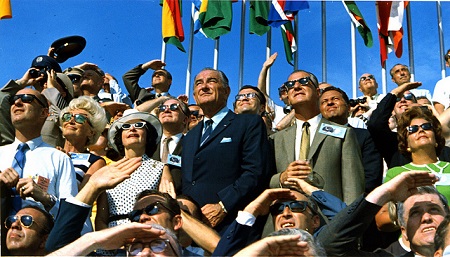When the Man in the Moon Met the Men on the Moon: Part 1
By Dianne Timblin
When the Apollo 11 astronauts landed on the Moon, we knew what it meant for science. We also knew what it meant for Cold War–era politics. But what did it mean for the arts? Would poets ever look at the Moon in the same way again?
July 20, 2015
Science Culture Communications Policy Aesthetics Astronautics Poetry
“From the dawn of civilization, the moon has been a source of mystery and wonderment to both man and beast,” educator Kathleen Ratto reflected in the journal Elementary English in December 1971. “Man has written stories, created myths, folk tales and fables, composed poetry and songs , calculated time, photographed, studied, theorized, and been challenged, aroused, and inspired by the moon.” But perhaps much of this was about to change.

Not even two full years had passed since Apollo 11 ’s July 20, 1969, Moon landing (followed by the first Moon walk the same day), yet already it seemed possible that the success of the Apollo program signaled an irrevocable shift in Americans’ view of Earth’s nearest celestial companion. This was certainly true on a literal level, as photographs and television feeds from the Apollo missions revealed more and more about the Moon’s surface. Perhaps it would prove true on a figurative level as well. Would a poetic ode to the Moon even make sense to future readers?
For Ratto, the Moon landings had provoked a new area of concern about her students, who lived, as she saw it, in a science-saturated time. Could the generation of students she was teaching, then in elementary school, learn to appreciate the Moon as metaphor? If not, a swath of moon-gazing mythology, literature, art, and music might eventually become meaningless.
“In the 20th century,” she opines, “because of modern science and technology, the mystery of the moon has in part been solved. Thanks mainly to Apollos 11 and 12, we know the moon to be a barren and remote body, devoid of life, covered by glasslike rocks and craters, a place that could not support human life unless our own atmosphere could be recreated and other Earth-like conditions simulated.” Although the statement certainly oversimplifies the missions’ findings, Ratto’s underlying concerns are earnest. (Hardly new, Ratto’s opinions were a space age version of longstanding arguments about the relationship between scientific discovery, poetry, and wonder. Centuries earlier, John Keats, who had trained as a surgeon, famously fretted about the influence of science on poetry.) What would it mean for the Moon to lose its aura of remoteness? Would it lose its mystique—and thereby its value to artists? When future poets, painters, scientists, dancers, engineers, illustrators, and musicians gazed at the Moon, would they no longer feel a sense of wonder?
Clearly Ratto was worried: “To the present-day child, the moon holds only scientific interest, for he is acquainted chiefly with mass-media and knows only our technological achievements.” The handful of students who might venture beyond the news would find little about the Moon of any metaphorical value, she believed: “Current poetry concerns itself with human rights, war, death, self-examination and retrospect, and sex.”
To awaken her students’ appreciation for the Moon, she had assembled a program of study about its depiction in myth, song, and story as far back as the ancient Greeks. After completing the unit, her pupils would then undertake scientific studies of the Moon.
By the time Ratto’s article appeared in December 1971, three successful Moon landings had followed closely behind Apollo 11 ’s pioneering voyage. Perhaps by then it was growing hard to imagine a time when humans wouldn’t regularly zip back and forth to the Moon. Would such familiarity breed, if not contempt, at least ennui?
Ratto needn’t have worried, of course. The Moon regained something akin to an aura of remoteness, as Cold War zeal for the space race waned and the Moon’s post-1972 guest list dropped to zero. And poets continued to uphold their end of the metaphorical bargain. Wonder at the universe generally, and at the Moon in particular, flourishes in contemporary poetry. (So much, in fact, that when I was studying poetry in graduate school, my classmates and I had a running joke about the Moon being in “poetry jail.” There it was, locked up alongside roses, tears, and—perhaps unexpectedly—roadkill. These were common enough lyric images that it seemed wise to proceed with either caution or utter flamboyance when adding them to a poem.) The lyric tradition has remained alive and well, as poems like “Moon Gathering,” by Eleanor Wilner (in which the crescent Moon reflected in water transforms from a fishhook to a sacrament being consumed), and “Let Evening Come,” by Jane Kenyon (“Let the stars appear / and the moon disclose her silver horn”) remind us.
But that doesn’t mean the Moon landings didn’t change the face of American poetry. As you’ll see in an upcoming post, the Apollo program launched several new categories of lunar poems.
American Scientist Comments and Discussion
To discuss our articles or comment on them, please share them and tag American Scientist on social media platforms. Here are links to our profiles on Twitter, Facebook, and LinkedIn.
If we re-share your post, we will moderate comments/discussion following our comments policy.